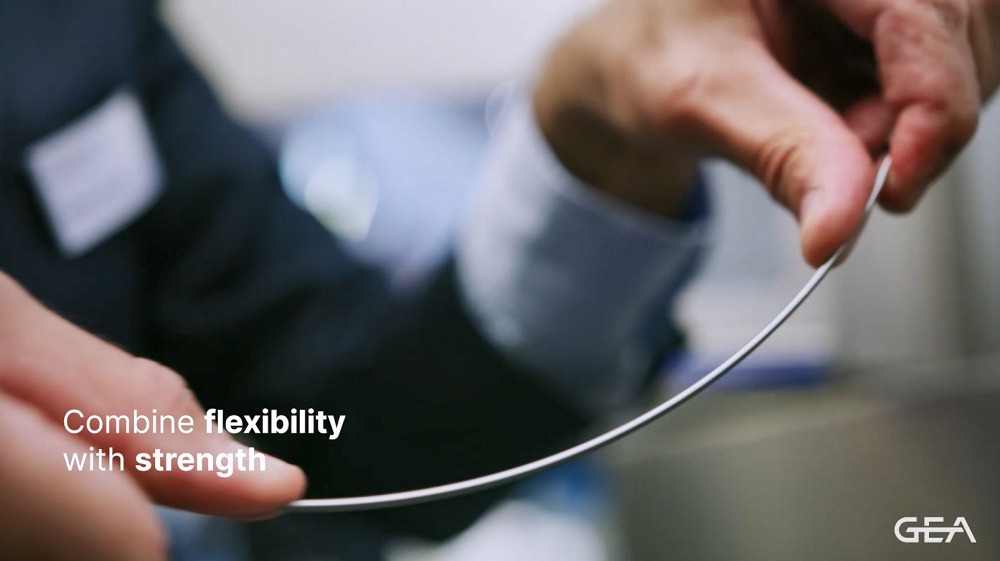
OptiFlex needles flex and recover their shape instead of bending or breaking when encountering bone-in parts, resulting in no bent needles and optimal injection performance for ham and bacon. OptiFlex needles also prevent clogging, reduce waste, and improve production processes, resulting in significant benefits for their customers.
Here, Wim Sturm, Product Sales Manager at GEA Food Solutions, addresses the advantages for operators using OptiFlex.
You describe GEA Optiflex needles as a “major step forward in injection quality.” How are Optiflex needles different?
Wim Sturm: What makes them unique is the patented metal alloy that is used. Optiflex needles have ‘shape memory.’ When you are injecting, and specifically for boned products, the needle can be deflected from the bone, and you get a bend in the needle. With standard regular stainless-steel needles, if the bend is too large, it stays in that position. Our Optiflex needle will deflect it, and not harm the product. Further, after extraction of the needle, it will return to its original shape.
Since OptiFlex needles are more resistant to damage from bending, does this mean a longer operational life?
Wim Sturm: Yes, they are more durable. In comparison to similar needles in the same application, OptiFlex are between 40-60% more durable.
In brining processes, how can using OptiFlex needles promote product quality and safety?

Wim Sturm: There are three things to consider. First: the product that is being injected, second, the machine, and third, the operator. When we look at the product, because the needle returns to its shape, it will always inject in the same position. If the needle is bent, when it goes down it will not inject in the same place that it should. So, that’s a major benefit for the product. This is especially important for brine dispersion. If you inject with a bent needle, that needle might penetrate the same place [as another needle] so you are injecting double, which would mean your brine dispersion is not optimum. Causing potential differences in product flavour, colouring, and microbiological product safety, affecting shelf life.
Secondly, from a machine perspective, if you have bent needles, you start damaging your machine, such as the needle guide plates (stripper plate). Thirdly, there is operator safety. If you have bent needles they could start breaking. As OptiFlex needles bend, and return to their original shape, that is very unlikely to happen.
OptiFlex needles are available in 2, 3, and 4mm diameter, and work in a close pattern. Why is this beneficial?
Wim Sturm: The 2mm needles are typically used in tender meats such as poultry, tender beef, and pork products, as well as fish. For more dense meats you need a stronger, more durable needle so you would swap to 3 or 4mm needles. We have an overlap pattern, and the distance, needle to needle for the 2mm injection, is approximately 7mm, which is very close. This means that you can inject with lower pressures. If you inject with high pressures, you are disturbing the meat fibres, so the lower you can keep this pressure, the less damage you will do, and the better product you will get.
How does this affect salt distribution?
Wim Sturm: The brine distribution is optimised, in comparison to conventional methods, because of the short distance you need to cover between the two needles. Again, the less pressure you need to use, the easier it will equalise within the product. You get better dispersion of the nitrate salts, and better, faster colouring, as well. This is also important in terms of shelf life. For bacon, it’s important that brine is both evenly injected and distributed, or you might have a problem when slicing later in the process.
With machines such as the GEA MultiJector, how does the filter technology work with the needles to reduce downtime for cleaning?
Wim Sturm: The filter technology we use means particles are not able to pass through the needle. But we do have one other special filter system – a gravity assisted system called ‘Screen Filter’ which allows us to filter out proteins when the brine is recycled from the injector. This means we can use that same brine for longer – because it is cleaner – with less filter blocking and less needle blocking.
How do MultiShakers, which provide transport, product spreading, brine settling and removal of excess brine in injection lines, work to activate ingredients and reduce yield loss?
Wim Sturm: For example, bacon would have a flip over conveyor and then the first MultiShaker is to close off the needle holes, locking the injected brine into the product, and activate the ingredients you have just injected, such as nitrate salts, phosphates, in the brine. It’s also removing excess brine, which is on the surface of the product, drying it. This excess brine can be recycled to the injector allowing for savings on brine losses. Sometimes, we have a second MultiShaker so that shaking time is prolonged, and activation of ingredients and protein is increased resulting in improved brine retention.
This second shaking also means less purge (drip) after injection. This is a natural process, and we can limit this by using a MultiShaker. So, further downstream in your production, you will have less drip on the floor, less cleaning, less cross contamination risks. Additionally, it means less yield loss. When you weigh the product after the shaker you know (the brine) is inside, so you have a more accurate measurement. Your downstream process may include tumbling, and this can allow for shorter tumbling times – that’s time saved, potentially increasing your tumbling capacity in the process.
What feedback have you had from the industry?
Wim Sturm: We have had some particularly valuable feedback. The less waste you have the more time you save cleaning. The less handling you have, the less brine spillage. The more parameters you can control, the more control you have of the outcome. If you go to the bottom line, that is where your competitive edge should be, with optimum process and production. Our aim is to give the best options to our customers so they can get the best results.
To learn more about this innovation, download the whitepaper below.
